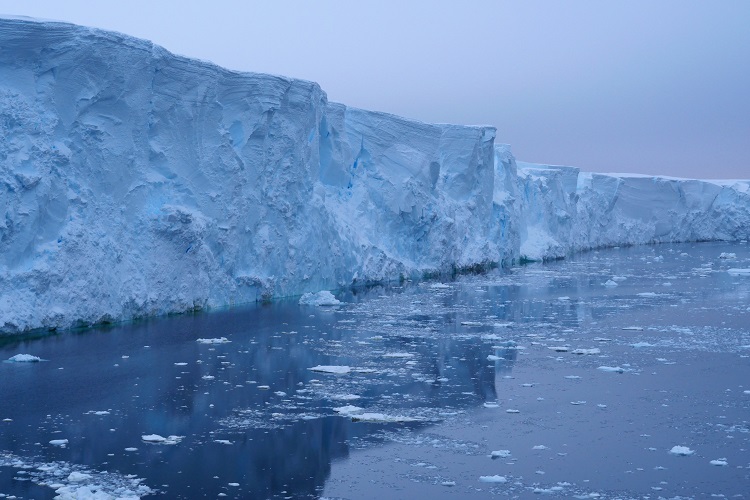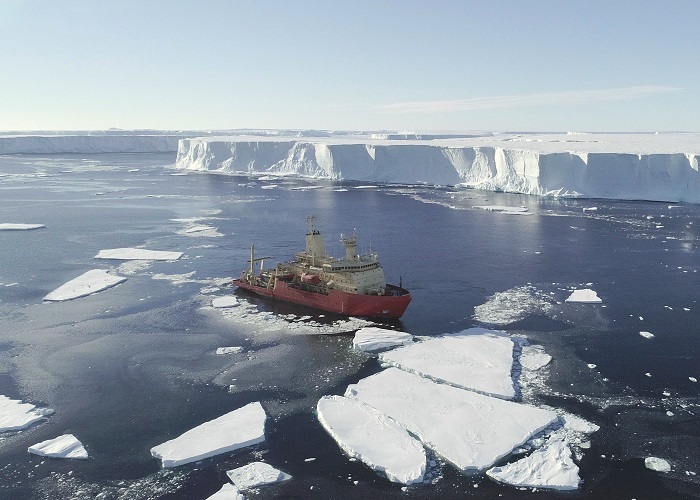
A new international study sheds light on the future of the massive Thwaites Glacier and other ice sheets.
The world's largest ice sheets may be in less danger of sudden collapse than previously predicted, according to new findings led by the University of Michigan, in partnership with the University of St Andrews as part of the International Thwaites Glacier Collaboration.
The team of international researchers have simulated the demise of one of the world's largest and most unstable glaciers, Thwaites Glacier in West Antarctica. The team of scientists modelled the collapse of various heights of ice cliffs, near-vertical formations that occur where glaciers and ice shelves meet the ocean, and found that instability doesn't always lead to rapid disintegration.
Thwaites Glacier covers 192,000 square kilometres (74,000 square miles), the size of the US state of Florida or Great Britain and is particularly susceptible to climate change.
Over the past 30 years, the overall rate of ice loss from Thwaites and its neighbouring glaciers has increased more than five-fold. Already, ice draining from Thwaites into the Amundsen Sea accounts for about four per cent of global sea-level rise. A run-away collapse of the glacier could lead to a significant increase in sea levels of around 65 cm (25 inches) and scientists want to find out if or when this could happen.
The new findings, published in Science (Friday 18 June 2021), add nuance to a previous theory called marine ice cliff instability, which suggested that if the height of an ice cliff reaches a certain threshold, it can suddenly disintegrate under its own weight in a chain reaction of ice fractures. The Thwaites Glacier in Antarctica, sometimes referred to as the 'Doomsday Glacier', is moving closer to this threshold.
The researchers combined the variables of ice failure and ice flow for the first time, finding that stretching and thinning of ice, as well as buttressing from trapped chunks of ice, may moderate the effects of fracture-induced marine ice cliff instability.
Lead researcher, Associate Professor, Jeremy Bassis, from the University of Michigan, said: "What we found is that over long timescales, ice behaves like a viscous fluid, sort of like a pancake spreading out in a frying pan. So, the ice spreads out and thins faster than it can fail and this can stabilize collapse. But if the ice can't thin fast enough, that's when you have the possibility of rapid glacier collapse."

The research team also found that icebergs that crack and fall away from the main glacier in a process known as "iceberg calving" may stave off, rather than contribute to, catastrophic collapse. If the ice chunks get stuck on outcroppings in the ocean floor, they can exert back pressure on the glacier to help stabilize it.
But Bassis notes that even if the glacier doesn't catastrophically collapse, exposing a tall cliff could still trigger retreat at a few kilometres per year - equal to the length of about 20 football fields and resulting in a large contribution to future sea level rise.
While it's clear that Thwaites and other glaciers are melting, the speed of their demise is of keen interest to coastal areas as they develop strategies to adapt and build resilience. But predicting the retreat of glaciers is a mind-bendingly complex business, as they are affected by the interplay of myriad factors: the stress and strain of billions of tons of shifting ice, changing air and water temperatures and the effects of flowing liquid water on ice, to name just a few. As a result, the predictions for the collapse of the Thwaites Glacier range from a few decades to many centuries. The new study is an important step toward producing accurate, actionable predictions.
Bassis explains: "There's no doubt that sea levels are rising, and that it's going to continue in the coming decades. But I think this study offers hope that we're not approaching a complete collapse - that there are measures that can mitigate and stabilize things. And we still can change things by making decisions about things like energy emissions, methane and CO2."
Co-author of the paper, Dr Anna Crawford, from the School of Geography and Sustainable Development at University of St Andrews, added that the study's findings will also be useful for predicting the fate of other glaciers and ice formations in the Arctic and Antarctica: "These important insights will inform future research into the retreat of Thwaites Glacier and other large outlet glaciers of the West Antarctic Ice Sheet that are vulnerable to retreat via ice-cliff failure and marine ice-cliff instability.
"They highlight the conditions that facilitate retreat, demonstrate the potential for terminus re-stabilisation and show how sea ice can actually put the brakes on the collapse process."
The research team is already working to refine their models further by incorporating additional variables that affect glacial retreat, including how the shapes of individual glaciers affect their stability and the interaction between glacial ice and the liquid ocean around it.
Bassis adds: "The ocean is always there, sort of tickling the ice in a very complex way, and we've only known for a decade or two just how important it is, but we're beginning to understand that it's driving a lot of the changes we're seeing, and I think that's going to be the next big frontier in our research."
The paper Transition to Marine Ice Cliff Instability Controlled by Ice Thickness Gradients and Velocity by J. N. Bassis, B. Berg, A. J. Crawford and D. Benn is published in the journal Science.
Please ensure that the paper's DOI 10.1126/science.abf6271 is included in all online stories and social media posts and that Science is credited as the source.
This study is part of the International Thwaites Glacier Collaboration, one goal of which is to provide the critical observations of past and present Thwaites behaviour to better test models and to predict with more certainty the future fate of the glacier.
The research was supported by the DOMINOS project, a component of the International Thwaites Glacier Collaboration, and by the National Science Foundation (grant number 1738896) and the Natural Environment Research Council (grant number NE/S006605/1).
The International Thwaites Glacier Collaboration (ITGC) is a five-year, $50 million joint US and UK mission to learn more about Thwaites Glacier, its past, and what the future may hold. Significant contributions to the research are also coming from Sweden, Germany and South Korea. The ultimate goal of the project is to predict how much Thwaites will contribute to global sea-level rise, and how soon a transition to more rapid ice retreat might occur. ITGC is funded by the US National Science Foundation (NSF) and UK Natural Environment Research Council (NERC).
Ice shelf is a large floating platform of ice that forms where a glacier or ice sheet flows down to a coastline and onto the ocean surface. Ice shelves are only found in Antarctica, Greenland, Canada, and the Russian Arctic.
Ice sheet, also known as a continental glacier, is a mass of glacial ice that covers surrounding terrain and is greater than 50,000 km2 (19,000 sq mi).
Glacier is a huge mass of ice that moves slowly over land. The term "glacier" comes from the French word glace (glah-SAY), which means ice. Glaciers are often called "rivers of ice".






